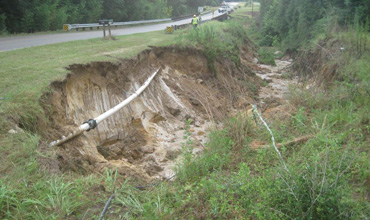The Role of Community-Based Forest Management on the Awareness of Watershed Protection and Conservation

Abstract:
Watersheds play an important role in our
ecological system especially to the communities surrounding it. In the
Philippines, domestic, industrial water and irrigation systems were supplied by
watersheds. However, not all watersheds are truly protected even though there
are several community-based forest management
programs implemented. Thus, this study tries to elicit the role of
community-based forest management on the awareness of watershed protection and
conservation.
In particular, it tries to 1) generate
baseline data on the demographic, livelihood activities, resources used of the
communities living within the watershed area of Calbayog Pan-as Falls Hayiban
Protected Landscape (CPHPL); 2) determine the relationship of the respondents’
profile to their level of awareness of watershed and to their existing
watershed protection and conservation practices; and 3) recommend programs and
policy that would strengthen community-based forest management protection.
The study was conducted in the five
upland communities of CPHPL, namely: Sitio Pena 2, Cango-maud, Danao 2, San
Rufino and Cag-anahaw. A descriptive-survey was used to assess the relationship
of awareness of watershed protection and demographic profile.
Results show that educational attainment
has a significant relationship (0.05% level) to the level of awareness on
watershed roles and functions in the environment among the upland communities.
This is despite most of the respondents (56.5%) have obtained primary
education.
This means, awareness of existing
watershed protection and conservation practices helps educate the people about
watershed conservation and protection. In fact, the presence of community-based
forest management program made the community moderately aware (33.2%) about
watershed protection.
References:
[1.]
Carig, E. T. (2012). Impact assessment of community-based forest management in
the Philippines: A case study of CBFM in Nueva Viscaya. International Conference on Management and Social Sciences. 17-21.
[2.]
Dolom, P. C. (2003). Criteria and indicators for assessing the sustainability
of a community-based forest management project in the Philippines. Unasylva 214-215. Volume 54. 22-26.
[3.]
Habtamu, T. (2011). Assessment of sustainable watershed management approach
case study Lenche Dima, Tsegur Eyesus and Dijji watershed. Project Paper for Master of Professional Studies. Cornell University.
[4.]
Harrison, P. (2006). Socio-economic study of forest-adjacent communities from
Nyanganje forest to Udzungwa scarp: a potential wildlife corridor.
Incorporating livelihood assessments and options for future management of
Udzungwa forests. WWF-Tanzania Programme
Office, Tanzania.
[5.]
Postel, S. L. & Thompson, B. H. Jr. (2005). Watershed protection: Capturing
the benefits of nature’s water supply services. National Resources Forum 29, 98-108.
[6.]
Wahab, MKA, Adewumi, A.A., & Ojo, SO. (2014). Assessment of socio-economic
activities and sustainable rural development in Oba hill forest reserves, Osun
State, Nigeria. E3 Journal of
Environmental Research and Management, Volume 5(5),. Retrieved from
http://wwwe3journals.org, November 2014.

